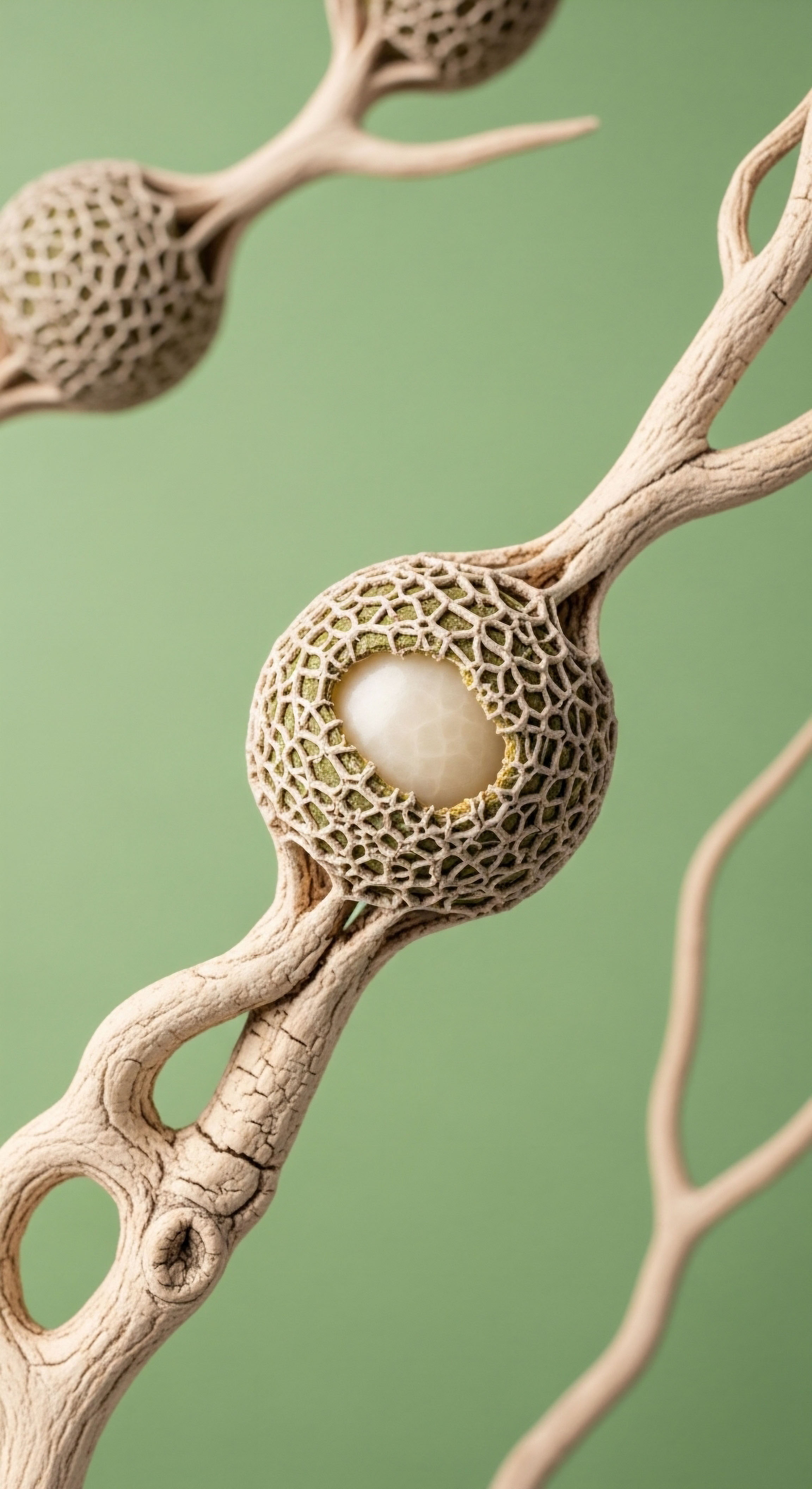

Fundamentals
You are meticulously tracking your hormonal optimization protocol, adhering to the schedule with precision. Simultaneously, you are dedicated to a diet rich in fibrous vegetables and whole grains, building a foundation of robust health from the ground up. It is a frustrating and confusing experience when these two paths, both aimed at achieving vitality, seem to produce conflicting results.
Your lived experience of this dissonance is not imagined; it is a direct reflection of a profound biological dialogue occurring within your gastrointestinal system. Your symptoms are data, providing a window into the intricate relationship between what you consume and how your body processes therapeutic hormones.
To understand this interaction, we must first reframe the digestive tract. It is a dynamic environment, a complex biochemical processing center that does far more than simply extract nutrients from food. It is a primary interface between the outside world and your internal systems, and it plays a critical role in regulating your endocrine health.
When you ingest an oral hormone, its journey is not a simple path from the stomach to the bloodstream. It is a complex voyage that is heavily influenced by the immediate chemical environment of the gut, an environment you directly shape with your dietary choices.

The Journey of an Oral Hormone
An orally administered hormone, such as estradiol or certain thyroid medications, enters the gastrointestinal system and must be absorbed through the intestinal wall to enter circulation. This is the first critical checkpoint where its efficacy can be altered. Dietary fiber, particularly soluble fiber found in foods like oats, apples, and beans, forms a gel-like substance in the gut.
This gel can physically trap hormone molecules, preventing them from reaching the intestinal lining for absorption. The result is that a portion of the prescribed dose may pass through your system without ever having the chance to exert its intended effect. This is a mechanical interference, a direct consequence of the physical properties of fiber.
Your dietary choices create the internal environment that determines how well your body can absorb and utilize oral hormonal therapies.
This initial interaction is only the beginning of the story. The gut is not a passive tube; it is an active participant in hormone metabolism, largely through the actions of its resident microbial community. This understanding moves us from a simple mechanical model to a more sophisticated biological one, where the food you eat feeds not just you, but also the trillions of microorganisms that have a direct say in your hormonal balance.

What Is the Gut’s Role in Hormone Processing?
Your body has a sophisticated system for managing and clearing hormones. After a hormone has circulated through the bloodstream and delivered its message, the liver modifies it through a process called conjugation. This process essentially attaches a molecule to the hormone, tagging it as “waste” and preparing it for excretion.
These conjugated, inactive hormones are then sent to the gut via bile, ready to be eliminated from the body. The gut’s role is to serve as the final exit route. However, the conditions within the gut can disrupt this process, creating a recycling loop that sends hormones back into your system, a topic we will explore in greater detail.


Intermediate
The interaction between dietary fiber and hormonal therapy extends far beyond simple mechanical obstruction in the gut. To truly grasp the connection, we must examine a specific and elegant biological pathway ∞ enterohepatic circulation.
This term describes a continuous recycling loop where substances, including hormones, are processed by the liver, excreted into the intestine with bile, and then reabsorbed from the intestine back into the bloodstream to return to the liver. This is your body’s internal system for conserving and managing valuable molecules. When you are on a hormonal optimization protocol, particularly with oral estrogens, this recycling system becomes a critical variable in the therapy’s effectiveness.

The Enterohepatic Recycling System
Think of the liver as a central processing hub. It takes circulating estrogens and conjugates them, packaging them for disposal. These packaged hormones travel into the small intestine. In a perfectly linear system, they would continue out of the body. However, the gut is not a linear system.
It is a dynamic environment populated by a vast community of bacteria, collectively known as the gut microbiome. Within this community is a specialized group of microbes with a very specific job related to hormone metabolism.

Meet Your Estrobolome the Gut Bacteria That Manage Estrogen
The estrobolome is the collection of bacteria in your gut that are capable of producing a specific enzyme ∞ beta-glucuronidase. This enzyme acts like a key, “unlocking” the conjugated estrogens sent from the liver. It cleaves off the molecule that the liver attached, reverting the hormone from its inactive, excretable form back into its free, active state.
Once freed, this active estrogen can be reabsorbed through the intestinal wall and re-enter circulation. This process directly increases the total amount of active estrogen in your body.
A high-fiber diet fundamentally alters the gut environment and the behavior of the estrobolome. Fiber acts as a prebiotic, providing fuel for certain families of beneficial bacteria. Many of these fiber-loving bacteria do not produce high levels of beta-glucuronidase. Consequently, a diet rich in fiber can lead to lower overall activity of this enzyme.
With less beta-glucuronidase activity, fewer conjugated estrogens are reactivated in the gut. More of them remain in their inactive state and are successfully excreted from the body, leading to a net decrease in circulating estrogen levels.
A high-fiber diet can reduce the recycling of estrogens by altering the gut microbiome, leading to lower overall hormone levels.
This mechanism explains how a diligently followed high-fiber diet can inadvertently work against an oral estrogen replacement protocol. You are taking a specific dose to achieve a target level of estrogen in your blood, but your diet is simultaneously enhancing the body’s ability to excrete it, effectively lowering the bioavailable dose you receive.
The following table illustrates the contrasting effects of low-fiber and high-fiber diets on this critical pathway.
| Metabolic Factor | Low-Fiber Diet Environment | High-Fiber Diet Environment |
|---|---|---|
| Gut Transit Time | Slower, allowing more time for microbial interaction and reabsorption. | Faster, reducing the window for hormone reabsorption. |
| Beta-Glucuronidase Activity | Can be higher, leading to significant deconjugation and reactivation of estrogens. | Generally lower, as fiber promotes bacteria that do not produce this enzyme. |
| Hormone Reabsorption | High. A significant portion of excreted estrogen is reactivated and returned to circulation. | Low. More estrogen remains conjugated and is eliminated from the body. |
| Net Effect on Circulating Estrogen | Tends to increase or maintain higher levels of circulating estrogens. | Tends to decrease levels of circulating estrogens. |

What Types of Hormones Are Most Affected?
This interaction is most pronounced for hormones that are taken orally and undergo significant enterohepatic circulation. This includes:
- Oral Estrogens ∞ Estradiol and estriol are primary examples. Their bioavailability can be directly reduced by a high-fiber diet.
- Thyroid Hormones ∞ Certain foods and fibers, like cottonseed meal and soybean flour, are known to decrease the absorption of levothyroxine.
- Oral Progesterone ∞ While not studied as extensively as estrogen in this context, the principle of gut absorption and metabolism remains relevant.
For hormonal therapies that bypass the gut, such as transdermal creams, subcutaneous injections (like Testosterone Cypionate), or pellets, this effect on initial absorption is not a factor. However, the influence of a high-fiber diet on the estrobolome still impacts the body’s handling of its own endogenous estrogen, which is a crucial consideration for overall hormonal balance, especially for individuals using aromatase inhibitors like Anastrozole to manage estrogen levels.


Academic
A systems-biology perspective reveals the gut-hormone relationship as a bidirectional and highly integrated axis. Hormonal status modulates the composition of the gut microbiome, and conversely, the microbiome, through metabolic activities like those of the estrobolome, profoundly influences the systemic hormonal milieu.
This intricate crosstalk has significant clinical implications for the efficacy and management of hormonal replacement therapies. The introduction of exogenous hormones does not occur in a vacuum; it occurs within a complex, adaptive biological system where diet is a powerful modulating variable.

A Systems Biology View Gut Hormone Axis and Therapeutic Efficacy
The efficacy of an oral hormonal therapy is determined by its pharmacokinetics, specifically its absorption, distribution, metabolism, and excretion (ADME). High-fiber diets can influence each of these stages. The binding of hormones to fiber in the gut lumen is a matter of absorption.
The modulation of the estrobolome and its beta-glucuronidase activity is a direct intervention in the metabolism and excretion phases. Studies have demonstrated that a high-fiber diet can increase fecal estrogen excretion by up to threefold while reducing plasma estrogen levels by 15-30%. This is a clinically significant alteration that can shift a patient from a therapeutic to a sub-therapeutic hormone level without any change in their prescribed dosage.
This dynamic is particularly critical for women on oral menopausal hormone therapy. A randomized trial might establish a standard dose of estradiol for symptom relief, but that trial assumes a standard dietary background. A patient adopting a very high-fiber diet for cardiovascular or metabolic health may experience a recurrence of menopausal symptoms, not because the therapy has stopped working, but because its bioavailability has been compromised by a well-intentioned dietary change.

How Does This Impact Different Clinical Protocols?
The clinical relevance of this interaction varies depending on the specific therapeutic protocol being employed. Understanding these distinctions is essential for personalized medicine.
- Oral Estrogen/Progesterone Therapy (Women) ∞ This is the most directly impacted protocol. The efficacy of oral estradiol, estriol, and progesterone is highly dependent on gut absorption and enterohepatic circulation. A high-fiber diet can substantially lower the effective dose, potentially undermining treatment goals for perimenopausal or postmenopausal women.
- Testosterone Replacement Therapy with Anastrozole (Men) ∞ While injectable testosterone bypasses the gut, the oral aromatase inhibitor, Anastrozole, does not. Although not a hormone, its absorption can be influenced by gut contents. More importantly, the man’s endogenous estrogen metabolism is still subject to the influence of the estrobolome. A high-fiber diet that lowers circulating estrogen could work synergistically with Anastrozole, potentially requiring a lower dose of the medication to achieve the desired estrogen modulation. Conversely, a low-fiber diet could increase estrogen recycling, placing a higher demand on the Anastrozole.
- Thyroid Hormone Therapy ∞ The impact of fiber on levothyroxine absorption is well-documented. Clinical guidelines often recommend taking this medication on an empty stomach, separated from food, supplements, and high-fiber meals, to ensure consistent absorption. This is a direct acknowledgment of the powerful role the gut environment plays in therapeutic efficacy.

Could Personalized Nutrition Optimize Hormonal Therapy Outcomes?
This complex interplay suggests that a one-size-fits-all approach to both diet and hormonal therapy is suboptimal. The future of personalized wellness may involve analyzing a patient’s gut microbiome to understand their specific estrobolome activity. Such data could inform dietary recommendations to either maximize or temper hormone recycling, allowing for more precise and stable hormonal optimization.
For instance, a patient with an overactive estrobolome might be counseled to increase fiber intake to help manage high estrogen levels, while a patient on oral HRT with low levels might be advised to carefully time their fiber intake away from their medication.
The following table summarizes key findings from studies on the diet-hormone interaction.
| Study Focus | Dietary Intervention | Key Biochemical Finding | Clinical Implication |
|---|---|---|---|
| Enterohepatic Circulation of Estrogen | Western Diet (High-Fat, Low-Fiber) vs. Vegetarian Diet (Moderate-Fat, High-Fiber) | Vegetarians had 3x higher fecal estrogen excretion and 15-20% lower plasma estrogen levels. | Diet is a primary regulator of the route of estrogen excretion and systemic hormone levels. |
| Fat and Fiber Effects on Sex Hormones | Shift from High-Fat/Low-Fiber to Low-Fat/High-Fiber | Significant decreases in serum estrone, estrone sulfate, testosterone, and androstenedione. | Both dietary fat and fiber independently and jointly influence a wide range of sex hormones. |
| Gut Microbiome and Estrogen | Review of Estrobolome Function | Gut bacteria producing beta-glucuronidase deconjugate estrogens, allowing for reabsorption. | The microbiome is a key endocrine modulator, directly controlling estrogen homeostasis. |
| Fiber and Levothyroxine Absorption | Dietary Fiber Intake with Thyroid Medication | Dietary fiber can decrease the absorption of levothyroxine from the gut. | Timing of medication relative to high-fiber meals is critical for therapeutic consistency. |

References
- Goldin, B R et al. “Diet and the excretion and enterohepatic cycling of estrogens.” Princess Takamatsu symposia vol. 16 (1985) ∞ 65-73.
- Adlercreutz, H et al. “Effect of dietary components, including lignans and phytoestrogens, on enterohepatic circulation and liver metabolism of estrogens and on sex hormone binding globulin (SHBG).” Journal of steroid biochemistry vol. 27,4-6 (1987) ∞ 1135-44. doi:10.1016/0022-4731(87)90193-9
- Woods, M N et al. “The effect of dietary fat and fiber on serum estrogen concentrations in premenopausal women under controlled dietary conditions.” Cancer vol. 74,3 Suppl (1994) ∞ 1052-60. doi:10.1002/1097-0142(19940801)74:3+3.0.co;2-s
- Kwa, M. Plottel, C. S. Blaser, M. J. & Adams, S. (2016). The Intestinal Microbiome and Estrogen Receptor-Positive Breast Cancer. Journal of the National Cancer Institute, 108(8), djw029. doi:10.1093/jnci/djw029
- Baker, J. M. Al-Nakkash, L. & Herbst-Kralovetz, M. M. (2017). Estrogen-gut microbiome axis ∞ Physiological and clinical implications. Maturitas, 103, 45 ∞ 53. doi:10.1016/j.maturitas.2017.06.025
- Dothard, M. I. Allard, S. M. & Gilbert, J. A. (2023). The effects of hormone replacement therapy on the microbiomes of postmenopausal women. Climacteric ∞ the journal of the International Menopause Society, 26(3), 182 ∞ 192. doi:10.1080/13697137.2023.2173568
- Mayo Clinic. “Levothyroxine (Oral Route) Precautions.” Mayo Foundation for Medical Education and Research, 2024.
- Fuhrman, B. J. et al. “Inverse associations of dietary fiber and menopausal hormone therapy with colorectal cancer risk in the Multiethnic Cohort Study.” American journal of clinical nutrition 102.5 (2015) ∞ 1199-1207.

Reflection

Integrating Your Body’s Systems
The information presented here is designed to connect your personal experiences with the underlying biological mechanisms that govern them. Your body is not a collection of separate parts but a fully integrated system. The fatigue you feel, the number on a lab report, and the food on your plate are all interconnected points in a single, complex network.
Understanding the dialogue between your digestive system and your endocrine system is a profound step toward taking intelligent and precise control of your health.
This knowledge transforms you from a passive recipient of a protocol into an active, informed partner in your own wellness journey. Consider how the timing of your meals, the composition of your diet, and the administration of your therapy might be orchestrated to work in concert.
This is the space where you can apply this clinical science to your own life, moving toward a state of optimized function that is calibrated specifically for you. The path forward involves a continued, curious, and compassionate conversation with your body, guided by data and a deeper appreciation for its intricate design.



